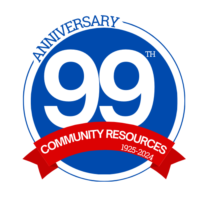In 1925, CRC was formed to focus on community planning of social services, social legislation, public education, and community welfare.
Over the years, CRC has promoted collaboration and discussion between organizations and community members. CRC was never positioned to “own” many programs, instead to identify gaps in available services and help develop organizations or programs that address the missing services. CRC’s mission is to connect the resources in our community through Collaboration, Advocacy, Research, and Education.
The following information was obtained from ninety years of board minutes and collections of historical documents as part of a large collection at the Kansas Historical Society.
Community Resources Council Timeline
-
Community Resources Council was originally named the Topeka Council of Social Agencies which was formed from the Community Chest. TCSA’s mission was to provide a facility for the interchange of ideas, community planning, endorsement of social legislation, and promotion of general public education and community welfare.
-
CRC assumed responsibility for the Social Service Index, now known as the Progress Reports. These reports are a culmination of information from the community and help other non-profits to better serve their community and apply for grants.
CRC coordinated with the University of Kansas to conduct studies on housing, care of the transient in Topeka, and care of the blind in Topeka.
CRC advocated for social legislation and public endorsements were made in the social legislation areas of maternity care, disabled children, and penal institutions.
-
1941: CRC was reorganized into a planning organization which led to the establishment of staff and a permanent location. Permanent committees were also formed at this time in the areas of health, social protections, welfare, and recreation.
1943: CRC established the first Christmas Bureau. Over 1,100 families registered but only 423 families were cared for due to lack of resources.
1945: CRC initiated a study called “Limited Survey of Facilities and Available Services of Health and Welfare.” Results of the survey recommended a more inclusive treatment center for children, families, and adults.
1945: CRC recommended the merger of the Shawnee County Guidance Center and Family Services of Topeka.
1945: CRC established Topeka Youth Centers, Inc. for junior high school students to age 23. Wagon Wheel: Basement of Women’s Club; Melody Mill & DownBeat: Monroe School; Hubba Hut: Oakland; Clock: McKinnley School; Happy Shack: Parkdale School.
1949: From Topeka Council of Social Agencies, CRC became known as Topeka Welfare Planning Council.
-
1950: Former chair of CRC became chair of the newly formed Shawnee County Guidance Center.
CRC became intertwined with the formation and the advising council of the Topeka Recreation Commission.
1954: CRC began offering free maternal health classes for new and expectant mothers. CRC partnered with the City of Topeka, Shawnee County Health Department, and the Shawnee County Medical Society to offer this to the community at no cost for ten years.
1958: The Charity Tax was terminated. This tax brought in 3.75 million dollars of funding for social services in the Topeka and Shawnee County community. This was devastating for the social welfare of our community. The termination of this tax lead to the formation of the United Fund – a separate entity at the time that operated in collaboration with CRC and shared an office and staff. The United Fund later became the United Way of Greater Topeka.
1958: CRC and the Shawnee County Association for Health prepared and facilitated a seminar to educate commission and city staff about the upcoming Urban Renewal Project. This seminar was named “When People Move” to warn the city staff and officials about the damages of displacing urban population.
1958: Family Service and Guidance Center opens after several studies and committees working with the mental health providers and many hours of CRC’s facilitation, coaching, and recommendations.
1959: Topeka Keyway Project, which focused on urban renewal projects, demolished 37 blocks of downtown Topeka and displaced 3,000 people. The displaced people were not relocated or offered any assistance after being forced to leave. Afterwards, the Topeka Housing Authority built the first large housing project of Topeka – Pine Ridge Manor.
1959: Romana Hood Memorial Fund was established and Romana Hood Award was established and continued until 2010. Romana Hood spent 17 years as CRC’s executive Secretary.
-
1961: CRC joins newly formed Topeka Housing Authority in planning for the public housing project later known as Pine Ridge Manor.
1962: CRC facilitated a series of community conversations called “Urban Renewal and Minority Housing in Topeka” after accusations from the community of wide-scale discrimination regarding the Urban Renewal Project.
1962: CRC assumed responsibility of the Volunteer Bureau.
1963: CRC leads the Mental Health Comprehensive Community Survey.
1963: CRC played an integral role in the formation of the Topeka Human Relations Commission.
1964: In response to the national war on poverty, federal funds became available to help alleviate poverty at the local level and CRC spearheaded the creation of the first Community Action program in Kansas in order to aid individuals in job searches, education opportunities, tax credits, and through other methods.
1965: CRC hired the first executive director for Community Action, Dr. Robert Harder.
1965: Pine Ridge Manor opened. The first year totaled 795 residents; 427 children and 368 adults.
1967: CRC and local public health services collaborate and adhere to Public Health Services Act of 1966 which mandates comprehensive health planning procedures. This later head to the first Comprehensive Health Plan, a mandate still active today. See Shawnee County Health Agency’s Community Health Improvement Plan.
1969: From Topeka Welfare Planning Council, CRC’s name is changed to Community Resources Council of Shawnee County.
-
1970s: CRC published the first comprehensive Service Directory of Area Agencies.
1972: Based on a direct response to community need, a study done by CRC showed that the elderly needed food assistance. Initially, the organization was called Mobile Meals of Topeka, Inc. and today, Meals on Wheels has 57 food routes in Topeka and 11 others in Jefferson and Shawnee County.
1975: United Fund merged with the Community Chest, the founding organization of CRC, and becomes modern-day United Way of Greater Topeka. The merger took over the now defunct Community Chest (which lost most of its funding with the demise of the Charity Tax in 1958). CRC’s close ties with United Fund later gave way to the United Way of Greater Topeka managing the large task of overseeing the annual Christmas Bureau.
1978: CRC and Interfaith of Topeka collaborated to study emergency aid services and formed Topeka & Shawnee County Emergency Aid Council.
-
1981: CRC forecasted a serious human service funding shortfall and publicly disclosed information regarding serious funding cuts to welfare and human service organizations in Topeka and Shawnee County.
1986: In collaboration with the Junior League, CRC established Project Concern, later called Project Topeka. This is a community-wide food drive for canned food and utility assistance. The first year of Project Topeka resulted in donations of 60,000 cans and $11,000.
1988: CRC began publishing the “Community Profile.” This is a summary and analysis of selected population, social, health, and economic factors. This publication was later renamed to “Community Trends and Indicators,” and now, “Community Progress Report.” This continues to be published and accessed for grant writing by area organizations.
-
1990: CRC began publication of the “Older Citizens Information.” This publication went to 4,000 senior households.
-
2001: CRC initiates the Topeka Ethnic Heritage Project: “Proud History of Ethnic Heritage” by surveying and gathering data for the City of Topeka.
2008: Heartland Healthy Neighborhoods (HHN) formed in partnership with CRC. CRC was instrumental in writing a grant that helped HHN become a coalition. CRC now has fiduciary management and adds structure to the organization.
2009: From Community Resources Council of Shawnee County, CRC became known as Community Resources Council (CRC).
-
2010: North Topeka (NOTO) Arts District was formed in partnership with CRC. After NOTO Arts Center reached out to CRC, we began to provide fiduciary management, corporate governance, and more. CRC has staffed the Arts Center in the past as well.
2013: In partnership with Topeka Public Schools and the Topeka Rescue Mission, CRC became the project head for the Avondale East NET Center Project. We re-purposed a retired 1960s school building into a Neighborhood Empowerment and Transformation Center which now houses nine non-profits and has been positively impacting the Hi-Crest West community.
2015: To celebrate 90 years, CRC announced a gift to the community and erected a bus shelter in conjunction with Topeka Metro on the Avondale East NET Center property to serve the community’s transportation needs. The shelter was funded by CRC and Wenger Fund.
-
COMIING SOON!


